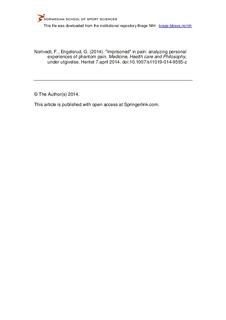“Imprisoned” in pain: Analyzing personal experiences of phantom pain
Journal article, Peer reviewed
Permanent lenke
http://hdl.handle.net/11250/194047Utgivelsesdato
2014-03-20Metadata
Vis full innførselSamlinger
- Artikler / Articles [2119]
Originalversjon
Medicine, Health care and Philosophy. 2014, under utgivelse. doi:10.1007/s11019-014-9555-z 10.1007/s11019-014-9555-zSammendrag
This article explores the phenomenon of “phantom pain.” The analysis is based on personal experiences elicited from individuals who have lost a limb or live with a paralyzed body part. Our study reveals that the ways in which these individuals express their pain experience is an integral aspect of that experience. The material consists of interviews undertaken with men who are living with phantom pain resulting from a traumatic injury. The phenomenological analysis is inspired by Zahavi (J Conscious Stud 8(5–7):151–167, 2001) and Merleau-Ponty (Phenomenology of perception. Routledge and Kegan Paul, London, 1962/2000). On a descriptive level the metaphors these patients invoke to describe their condition reveal immense suffering, such as a feeling of being invaded by insects or of their skin being scorched and stripped from their body. Such metaphors express a dimension of experience concerning the self that is in pain and others whom the sufferer relates to through this pain, as well as the agony that this pain inflicts in the world of lived experience. This pain has had a profound impact on their lives and altered their relationship with self (body), others and the world. Their phantom pain has become a reminder of their formerly intact and functioning body; they describe the contrast between their past and present body as an ambiguous and disturbing experience. We conclude that these sensitive and personalized experiences of phantom pain illuminates how acts of expression—spoken pain—constitute a fundamental dimension of a first-person perspective which contribute to the field of knowledge about “phantom pain”.
Beskrivelse
© The Author(s) 2014. This article is published with open access at Springerlink.com
